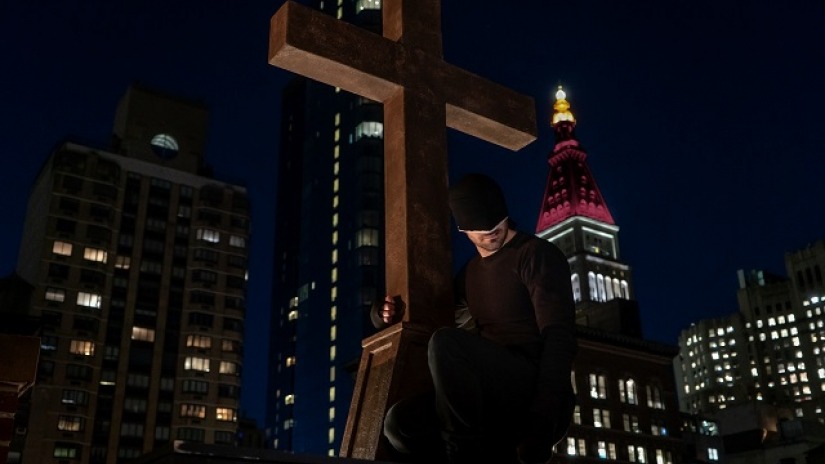Netflix’s Daredevil Returns To Form In Season 3

Some people may lament the fact that Season 3 of the Netflix series Daredevil echoes much of Season 1, but when that echo comes in the form of the powerhouse performance by Vincent D’Onofrio as Wilson Fisk, or the marvelous (pun intended) interplay between Matt Murdock (Charlie Cox), Foggy Nelson (Elden Henson) and Karen Page (Deborah Ann Woll), I’m all ears.
Or maybe a better analogy would be that this season is like a really good chili — an awesome first serving but even better as leftovers after the flavors have combined and melded into new levels of deliciousness. So below is my spoiler-free review of Daredevil Season 3, with no more reveals than you would have got from watching the trailers and commercials.
The third season is based very loosely on the “Born Again” story arc by Frank Miller and David Mazzuchelli that ran from issues #227–233 in the Daredevil comic book. Season 3 picks up right after the end of The Defenders (OK, SPOILER ALERT if you haven’t seen that show) with Matt bleeding and broken in a bed in a church basement. That scene happens in the comics too, but not until midway through the run, so you know the details and structure of Born Again will be adjusted for a 13-episode series and to fit the previous seasons. However, many of the familiar elements from the comics are in Season 3, just at different times or having different roles in the series.
Most notable is the return of Kingpin. D’Onofrio hasn’t lost a step in his portrayal of Wilson Fisk as a chillingly fascinating rage-filled sociopath — a criminal manipulator that would make Machiavelli blush and Kilgore wonder why he needed powers when all Fisk needs is money and fear. There is no doubt in my mind that the Netflix versions of Marvel’s New York City heroes work best, and maybe only, when they have a singular, powerful and fascinating villain to confront.
Playing a bad Hand
It is obvious now that the use of the villainous group The Hand in Season 2 of Daredevil, and the first seasons of Iron Fist and The Defenders, was a mistake. Jessica Jones had one of the best villains ever put into a series in Kilgore, and while there was a single villain in the second season of that show, it wasn’t anyone with the same fascinating frightfulness. The Hand, on the other … hand, was a mostly nebulous group of mystical ninjas and warriors with a whole bunch of leaders, often at odds with one another. Unlike Fisk or Kilgore, with such an array of mostly poorly defined villainous leaders, you don’t get the in-depth exploration of how and why they are villains. So you aren’t that invested in their parts of the stories, or able to be as worried or frightened for the heroes they oppose.
Also familiar from Season 1 is the bravura directing and amazing fight choreography. There is a single-take fight scene that will remind you of the hallway fight in Season 1, but even longer and more complicated. And it boggles my mind how one actor without martial arts training (Cox) can look so good in fights when another (Iron Fist’s Finn Jones) can look so uninvolved.
Even the secondary characters get deeper development in Season 3. We get to see more of Foggy’s happy childhood and family, and Karen’s much less happy one. But it is a new character that is most interesting and well executed. The way the show slowly introduces us to the antagonist (it’s not really fair to call him a villain like Fisk or Kilgore) Bullseye is wonderful. He is a very complicated, conflicted and ultimately disturbing character — so much more so than when Colin Farrell played him in the mostly forgettable 2003 movie. And how the director portrays his ability is so much more satisfying than the tired slow-mo trope of the movie.
Not everything is perfect of course. Season 3 suffers from the same problem every first season in the Marvel Netflix universe has had — that 13 episodes is too long for a show designed to be binge watched. In a standard three-act movie, having the end of Act 2 or the beginning of Act 3 slower in pace than the rest is fine, since it is only 10-15 minutes or so. In a 13-episode series, having that same policy means at least one entire hour will be slow. That can kill the momentum in a way that will end the series right there for some viewers. Daredevil Season 3 would have been better if it was 10 episodes like Luke Cage‘s or Iron Fist‘s second seasons.
That said, Season 3 of Daredevil is the best single season in the Netflix Marvel universe, just barely ahead of the first season of Jessica Jones.



